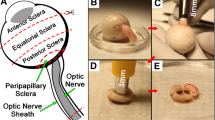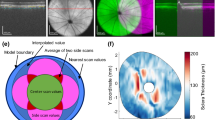Abstract
To test the hypothesis that mechanical strain in the posterior human sclera is altered with age, 20 pairs of normal eyes from human donors aged 20 to 90 years old were inflation tested within 48-h postmortem. The intact posterior scleral shells were pressurized from 5 to 45 mmHg, while the full-field three-dimensional displacements of the scleral surface were measured using laser speckle interferometry. The full strain tensor of the outer scleral surface was calculated directly from the displacement field. Mean maximum principal (tensile) strain was computed for eight circumferential sectors (\(45^{\circ }\) wide) within the peripapillary and mid-peripheral regions surrounding the optic nerve head (ONH). To estimate the age-related changes in scleral strain, results were fit using a functional mixed effects model that accounts for intradonor variability and spatial autocorrelation. Mechanical tensile strain in the peripapillary sclera is significantly higher than the strain in the sclera farther away from the ONH. Overall, strains in the peripapillary sclera decrease significantly with age. Sectorially, peripapillary scleral tensile strains in the nasal sectors are significantly higher than the temporal sectors at younger ages, but the sectorial strain pattern reverses with age, and the temporal sectors exhibited the highest tensile strains in the elderly. Overall, peripapillary scleral structural stiffness increases significantly with age. The sectorial pattern of peripapillary scleral strain reverses with age, which may predispose adjacent regions of the lamina cribrosa to biomechanical insult. The pattern and age-related changes in sectorial peripapillary scleral strain closely match those seen in disk hemorrhages and neuroretinal rim area measurement change rates reported in previous studies of normal human subjects.







Similar content being viewed by others
References
Airaksinen PJ, Mustonen E, Alanko HI (1981) Optic disc hemorrhages. Analysis of stereophotographs and clinical data of 112 patients. Arch Ophthalmol 99:1795–1801
Albon J, Farrant S, Akhtar S et al (2007) Connective tissue structure of the tree shrew optic nerve and associated ageing changes. Invest Ophthalmol Vis Sci 48:2134–2144
Albon J, Karwatowski WS, Avery N, Easty DL, Duance VC (1995) Changes in the collagenous matrix of the aging human lamina cribrosa. Br J Ophthalmol 79:368–375
Avetisov E, Savitskaya N, Vinetskaya M, Lomdina E (1983) A study of biochemical and biomechanical qualities of normal and myopic eye sclera in humans of different age groups. Metab Pediatr Syst Ophthalmol 7:183–188
Bailey AJ, Paul RG, Knott L (1998) Mechanisms of maturation and ageing of collagen. Mech Ageing Dev 106:1–56
Bellezza AJ, Hart RT, Burgoyne CF (2000) The optic nerve head as a biomechanical structure: initial finite element modeling. Invest Ophthalmol Vis Sci 41:2991–3000
Bornert M, Bre’mand F, Doumalin P et al (2009) Assessment of digital image correlation measurement errors: methodology and results. Exp Mech 49:353–370
Burgoyne CF, Downs JC (2008) Premise and prediction—how optic nerve head biomechanics underlies the susceptibility and clinical behavior of the aged optic nerve head. J Glaucoma 17:318–328
Chumbley LC, Brubaker RF (1976) Low-tension glaucoma. Am J Ophthalmol 81:761–767
Coudrillier B, Tian J, Alexander S, Myers KM, Quigley HA, Nguyen TD (2012) Biomechanics of the human posterior sclera: age- and glaucoma-related changes measured using inflation testing. Invest Ophthalmol Vis Sci 53:1714–1728
Dormann CF (2007) Effects of incorporating spatial autocorrelation into the analysis of species distribution data. Global Ecol Biogeogr 16:129–138
Dormann CF, McPherson JM, Araujo MB et al (2007) Methods to account for spatial autocorrelation in the analysis of species distributional data: a review. Ecography 30:609–628
Downs JC, Suh JK, Thomas KA, Bellezza AJ, Burgoyne CF, Hart RT (2003) Viscoelastic characterization of peripapillary sclera: material properties by quadrant in rabbits and monkeys. J Biomech Eng 125:124–131
Downs JC, Suh JK, Thomas KA, Bellezza AJ, Hart RT, Burgoyne CF (2005) Viscoelastic material properties of the peripapillary sclera in normal and early-glaucoma monkey eyes. Invest Ophthalmol Vis Sci 46:540–546
Drance S, Anderson DR, Schulzer M (2001) Collaborative Normal-Tension Glaucoma Study Group. Risk factors for progression of visual field abnormalities in normal-tension glaucoma. Am J Ophthalmol 131:699–708
Eilaghi A, Flanagan J, Simmons C, Ethier CR (2010a) Effects of scleral stiffness properties on optic nerve head biomechanics. Ann Biomed Eng 38:1586–1592
Eilaghi A, Flanagan J, Tertinegg I, Simmons CA, Brodland WG, Ethier RC (2010b) Biaxial mechanical testing of human sclera. J Biomech 43:1696–1701
European Glaucoma Prevention Study (EGPS) Group (2007) Predictive factors for open-angle glaucoma among patients with ocular hypertension in the European glaucoma prevention study. Ophthalmology 114:3–9
Fazio MA, Bruno L, Reynaud JF, Poggialini A, Downs JC (2012a) Compensation method for obtaining accurate, sub-micrometer displacement measurements of immersed specimens using electronic speckle interferometry. Biomed Opt Express 3:407–417
Fazio MA, Grytz R, Bruno L, Girard MJ, Gardiner S, Girkin CA, Downs JC (2012b) Regional variations in mechanical strain in the posterior human sclera. Invest Ophthalmol Vis Sci 53:5326–5333
Geijssen HC (1991) Studies on normal pressure glaucoma. Kugler Publications, Amsterdam
Geraghty B, Jones SW, Rama P, Akhtar R, Elsheikh A (2012) Age-related variations in the biomechanical properties of human sclera. J Mech Behav Biomed Mater 16:181–191
Girard MJ, Downs JC, Bottlang M, Burgoyne CF, Suh JK (2009a) Peripapillary and posterior scleral mechanics, part II \(\backslash {226}\) experimental and inverse finite element characterization. J Biomech Eng 131:051012
Girard MJ, Suh JK, Bottlang M, Burgoyne CF, Downs JC (2009b) Scleral biomechanics in the aging monkey eye. Invest Ophthalmol Vis Sci 50:5226–5237
Girard MJ, Suh JK, Bottlang M, Burgoyne CF, Downs JC (2011) Biomechanical changes in the sclera of monkey eyes exposed to chronic IOP elevations. Invest Ophthalmol Vis Sci 52:5656–5669
Grytz R, Meschke G, Jonas JB (2011) The collagen fibril architecture in the lamina cribrosa and peripapillary sclera predicted by a computational remodeling approach. Biomech Model Mech 10:371–382
Healey PR, Mitchell P, Smith W, Wang JJ (1998) Optic disc hemorrhages in a population with and without signs of glaucoma. Ophthalmology 105:216–223
Hernandez MR, Luo XX, Andrzejewska W, Neufeld AH (1989) Age-related changes in the extracellular matrix of the human optic nerve head. Am J Ophthalmol 107:476–484
Kass MA, Heuer DK, Higginbotham EJ, et al. (2002) The Ocular Hypertension Treatment Study: a randomized trial determines that topical ocular hypotensive medication delays or prevents the onset of primary open-angle glaucoma. Arch Ophthalmol 120:701–713; discussion 829–830
Leske MC, Connell AM, Wu SY, Hyman L, Schachat AP (1997) Distribution of intraocular pressure: the Barbados Eye Study. Arch Ophthalmol 115:1051–1057
Leske MC, Heijl A, Hyman L et al (2004) Factors for progression and glaucoma treatment: the Early Manifest Glaucoma Trial. Curr Opin Ophthalmol 15:102–106
Levene RZ (1980) Low tension glaucoma: a critical review and new material. Surv Ophthalmol 24:621–664
Morris JS, Baladandayuthapani V, Herrick RC, Sanna P, Gutstein HB (2011) Automated analysis of quantitative image data using isomorphic functional mixed models with application to proteomics data. Ann Appl Stat 5:894–923
Morris JS, Carroll RJ (2006) Wavelet-based functional mixed models. J R Stat Soc B Met 68:179–199
Morrison JC, LHernault NL, Jerdan JA, Quigley HA (1989) Ultrastructural location of extracellular matrix components in the optic nerve head. Arch Ophthalmol 107:123–129
Norman RE, Flanagan JG, Sigal IA, Rausch SM, Tertinegg I, Ethier CR (2011) Finite element modeling of the human sclera: influence on optic nerve head biomechanics and connections with glaucoma. Exp Eye Res 93:4–12
Robert L, Nazaret F, Cutard T, Orteu J (2007) Use of 3-D digital image correlation to characterize the mechanical behavior of a fiber reinforced refractory castable. Exp Mech 47:761–773
Roberts M, Liang Y, Sigal IA et al (2010) Correlation between local stress and strain and lamina cribrosa connective tissue volume fraction in normal monkey eyes. Invest Ophthalmol Vis Sci 51:295–307
Rudnicka AR, Mt-Isa S, Owen CG et al (2006) Variations in primary open-angle glaucoma prevalence by age, gender, and race: a Bayesian meta-analysis. Invest Ophthalmol Vis Sci 47:4254–4261
Schreier HW, Braasch JR, Sutton MA (2000) Systematic errors in digital image correlation caused by intensity interpolation. Opt Eng 39:2915–2921
See J, Nicolela M, Chauhan B (2009) Rates of neuroretinal rim and peripapillary atrophy area change: a comparative study of glaucoma patients and normal controls. Ophthalmology 116:840–847
Sigal IA, Flanagan J, Ethier CR (2005) Factors influencing optic nerve head biomechanics. Invest Ophthalmol Vis Sci 46:4189–4199
Sigal IA, Flanagan JG, Tertinegg I, Ethier CR (2004) Finite element modeling of optic nerve head biomechanics. Invest Ophthalmol Vis Sci 45:4378–4387
Sigal IA, Yang H, Roberts M, Burgoyne CF, Downs JC (2011) IOP-induced lamina cribrosa displacement and scleral canal expansion: an analysis of factor interactions using parameterized eye-specific models. Invest Ophthalmol Vis Sci 52:1896–1907
Tang J, Liu J (2012) Ultrasonic measurement of scleral cross-sectional strains during elevations of intraocular pressure: method validation and initial results in posterior porcine sclera. J Biomech Eng 134:091007
The AGIS Investigators. The advanced glaucoma intervention study (AGIS): 12 (2002) Baseline risk factors for sustained loss of visual field and visual acuity in patients with advanced glaucoma. Am J Ophthalmol 134:499–512
Weih LM, Mukesh BN, McCarty CA, Taylor HR (2001) Association of demographic, familial, medical, and ocular factors with intraocular pressure. Arch Ophthalmol 119:875–880
Woo S, Kobayashi A, Schlegel W, Lawrence C (1972) Nonlinear material properties of intact cornea and sclera. Exp Eye Res 14:29–39
Yamamoto T, Iwase A, Kawase K, Sawada A, Ishida K (2004) Optic disc hemorrhages detected in a large-scale eye disease screening project. J Glaucoma 13:356–360
Acknowledgments
This paper was supported by NIH Grants R01-EY18926 (PIs: J. Crawford Downs, Christopher A. Girkin), and R01-CA107304 (PI: Jeffrey S. Morris).
Author information
Authors and Affiliations
Corresponding author
Rights and permissions
About this article
Cite this article
Fazio, M.A., Grytz, R., Morris, J.S. et al. Age-related changes in human peripapillary scleral strain. Biomech Model Mechanobiol 13, 551–563 (2014). https://doi.org/10.1007/s10237-013-0517-9
Received:
Accepted:
Published:
Issue Date:
DOI: https://doi.org/10.1007/s10237-013-0517-9




